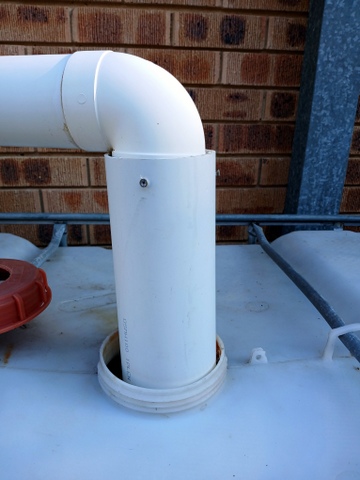
About eight years ago our next door neighbours put a deck on the front of their house. As part of that they wanted to direct the rainwater runoff to an IBC (intermediate Bulk container) beside the house so they would have 1000 litres of rainwater to water the plants with. Normally this would mean running a downpipe horizontally just under the roof from the gutter until it was over the IBC then through a 90° elbow down into the IBC itself. This would be referred to as a ‘dry’ catchment system in that once the rain stops, the piping all dries out. This is the way we have done all of ours. Unfortunately they wanted to put in a screen on that side and the downpipe would have gotten in the way.

Downpipe from the gutter to the buried section of pipe
The way that they got around it was to put in a ‘wet’ system which means the downpipe is run down the side of the Deck and into the ground. From there it runs underground until it gets near the IBC, then it pops out of the ground, up the side of the IBC and into the top. This results in the underground section and parts of the in and out pipes remaining full of water permanently. As part of the system there also needs to be some method of allowing for the overflow once the IBC is full of water. In this case a hole was cut in the IBC and a pipe used to deflect the overflow into an existing downpipe sitting beside the IBC.

Rainwater gets directed into the top of the IBC
There are advantages to this ‘wet’ system, the main one seemingly being that they are less aesthetically messy, especially if you have a complicated system of tanks and roofs to connect, because the pipes and connections will be underground and not visible. The wet system also makes it easier to place water tanks anywhere on the property by running the pipes underground, and not just having tanks standing next to the roof they are draining. However, for the most part the simpler dry system works best.

The pipes rise out of the ground next to the IBC to deliver the water into it

When full the IBC overflows via this pipe into a nearby downpipe
One downside of the wet system is that once material has been washed off the roof (eg leaves, dirt, dead birds etc) it can be difficult for the system to be cleaned because the underground section is always filled with water (the charged line). This can result in tannin leaching from leaves discolouring the water, and/or anaerobic fermentation giving the stormwater a foul smell. There are two design features that can prevent, or at least reduce, these problems but they have, unfortunately, not been included in this particular system. They are –
1. A first flush diverter – this takes the first bit of rain that washes all the dust and rubbish from the roof and diverts it onto the ground before it gets to the tank. It is comparatively easy to do and could be installed in the horizontal section drainpipe after it comes out of the roof gutter and before it heads vertically down into the underground section.

This section would be ideal for a first flush diverter
First flush diverter on one of our tanks
2. A drain that allows the water from the charged line to be removed so it can be flushed and cleaned. This is a little trickier in this case because to work it must be installed at the lowest part of the system, and the lowest part of the system is the underground pipe. A valve could be installed to allow the charged line to be drained, but a hole would need to be dug in the appropriate place, and the water coming out of the valve would need to be directed into a pit close by, which would also have to be dug.
The first flush diverter would be a quick and simple fix, but some thought would need to be given to how to install the drain for the charged line and the drainage pit!

Tap and hose for accessing the water in the IBC



